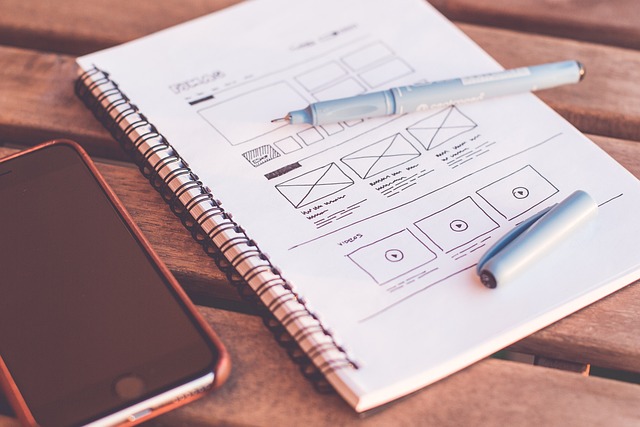Web design has evolved dramatically, driven by tech advancements, user needs, and creative trends, transforming into an art that balances aesthetics and functionality. Modern web design prioritizes responsive strategies for optimal experiences across devices, UX principles for intuitive navigation and engagement, and visual aesthetics to enhance brand recognition. Key elements include responsive layouts, clean typography, strategic color schemes, and interactive features. The future promises exciting trends like enhanced mobile responsiveness, minimalism, AR/VR integration, and continued focus on user-centric design.
In the dynamic landscape of modern web design, understanding evolution is key to staying ahead. This article delves into the transformation of web design over time, highlighting crucial elements that define today’s trends. From responsive design adapting seamlessly to all screens to user experience (UX) as a fundamental cornerstone, we explore visual aesthetics, branding, and future shifts shaping this dynamic field. Uncover insights on creating engaging, accessible, and aesthetically pleasing websites that cater to diverse users and technologies.
Understanding the Evolution of Web Design

The evolution of web design is a fascinating journey that reflects the constant shift in technology, user expectations, and creative trends. In its early days, websites were relatively simple, primarily serving as digital versions of print media. Static HTML pages with basic text and images were the norm, lacking interactivity and visual appeal. As browsers advanced and internet connectivity improved, web design started to transform. The introduction of CSS (Cascading Style Sheets) brought about a revolution, allowing designers to create visually rich and more dynamic websites. This period marked the beginning of web design as an art form, where aesthetics and functionality began to intertwine.
Over time, the rise of responsive design, mobile-first approaches, and user-centric design principles further propelled the evolution. With the proliferation of smartphones and tablets, designers needed to adapt their creations for various screen sizes and orientations. This led to a focus on clean layouts, intuitive navigation, and optimized content delivery. Today, modern web design encompasses not just aesthetics but also usability, accessibility, and performance optimization. Designers now have a vast toolkit at their disposal, including JavaScript frameworks, advanced CSS techniques, and user experience (UX) design methodologies, enabling them to create immersive, interactive, and personalized digital experiences for users worldwide.
Key Elements of Modern Web Design

In the realm of modern web design, several key elements stand out as essential components for creating visually appealing and user-friendly online experiences. Firstly, responsive design is paramount, ensuring websites adapt seamlessly to various devices and screen sizes. This adaptability is crucial for providing an optimal viewing experience across desktops, tablets, and smartphones. Additionally, a clean and intuitive layout with ample white space enhances readability and navigability, allowing users to find information efficiently.
Color schemes play a significant role in setting the tone and atmosphere of a website. Modern web design often embraces minimalism, utilizing neutral tones as a base and incorporating subtle accents to draw attention to key elements. Typography is another vital aspect; choosing the right fonts and styles not only improves readability but also contributes to the overall aesthetic and brand identity. Interactive elements such as animations and micro-interactions add a layer of engagement, making user experiences more dynamic and memorable.
Responsive Design: Adapting to All Screens

Modern web design places a strong emphasis on responsive design, ensuring that websites seamlessly adapt to various screen sizes and devices. This approach is pivotal in today’s digital landscape where users access the internet through desktops, tablets, and smartphones alike. Responsive design techniques involve utilizing flexible layouts, images, and CSS media queries to provide an optimal viewing experience regardless of the user’s hardware.
By implementing responsive design strategies, web designers can create a unified user experience across different platforms. This not only enhances accessibility but also improves search engine optimization (SEO) rankings. Google, for instance, favors mobile-friendly websites in its search results, making responsive design an indispensable aspect of contemporary web design practices.
User Experience (UX) as a Cornerstone

In modern web design, User Experience (UX) stands as a cornerstone, shaping how users interact with and perceive websites. A well-crafted UX ensures that sites are intuitive, easy to navigate, and visually appealing, fostering user engagement and loyalty. It involves understanding user needs, behaviors, and expectations, then translating that knowledge into seamless digital experiences.
Effective web design leverages UX principles to create interfaces that offer a smooth flow of information, clear calls to action, and consistent branding. By prioritizing user satisfaction, designers can build websites that not only meet but exceed expectations, ultimately driving conversions and business growth. This holistic approach to web design considers every touchpoint, from initial website visits to repeat engagements, ensuring a positive and memorable experience for all users.
Visual Aesthetics and Branding

In modern web design, visual aesthetics play a pivotal role in capturing users’ attention and fostering brand recognition. The look and feel of a website are essential components that contribute to a seamless user experience. Through thoughtful color schemes, typography, and layout choices, designers can create visually appealing interfaces that align with a brand’s identity. This strategic approach ensures that the website not only looks aesthetically pleasing but also serves as a powerful branding tool, leaving a lasting impression on visitors.
Branding is a key aspect that distinguishes one business from another in the digital realm. A well-designed website acts as a virtual representation of a company’s values, mission, and personality. By integrating brand elements consistently throughout the web design, businesses can establish a strong visual connection with their target audience. This includes logo placement, color palettes derived from brand guidelines, and typography that reflects the brand’s tone and character, ultimately driving brand recognition and user engagement in a competitive online market.
Future Trends Shaping Web Design

The future of web design is exciting, with several trends emerging that challenge conventional norms and push creative boundaries. One prominent trend is the rise of responsive design that adapts seamlessly to various devices and screen sizes. As more users access the internet through mobile phones and tablets, designers must prioritize flexibility and adaptability in their layouts. This ensures a consistent user experience across different platforms, enhancing accessibility and usability.
Additionally, minimalism is set to continue as a strong trend, focusing on clean lines, ample white space, and straightforward navigation. This approach simplifies content delivery, making websites faster to load and easier to navigate. Furthermore, the integration of augmented reality (AR) and virtual reality (VR) technologies in web design offers immersive experiences that blur the line between physical and digital environments. These innovations not only captivate users but also open up new possibilities for interactive storytelling and product visualization.
